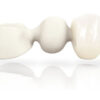- By - Malfaifi
- Posted on
- Posted in Implant Dentistry
Assessment of implant stability
Assessment of implant stability as a prognostic determinant
Meredith 1998

- Clinicians have reported success rates for implants as high as 90%.
Endosseous Implants
- Osseointegration has been defined as “a process whereby a clinically asymptomatic rigid fixation of alloplastic materials is achieved and maintained in bone during functional loading.”
- Implant survival and implant success are quite different concepts, survival commonly referring to the retention of the implant within the jaws of the patient.
Primary stability
- Is necessary at the time of implant placement, and secondary stability is needed following osseointegration, which occurs in function.
- If an implant is not sufficiently stable at the time of placement, micromotion may occur.
- The normal healing process may then be disrupted, and a capsule of fibrous tissue may form, resulting in mobility of the implant and its subsequent clinicalfailure
- Using smaller drill than implant result in hoop stresses. Such stresses may be beneficial in enhancing the primary stability of an implant, but they can reach a sufficiently high level to result in necrosis and local ischemia of the bone at the implant-tissue interface.
Secondary Stability
Healing, Bone Formation, Osseointegration
Measurement of Implant Stability and Osseointegration
- Initially it was believed that osseointegration could be assessed by tapping an implant and an abutment with a metallic instrument. The aim of such a test was to determine the resonances and damping of an implant from the audible ringing produced.
- Test is relatively insensitive to changes in implant stability for two reasons: first, the ear is insufficiently sensitive to discriminate the resonance frequency, damping and amplitude of the tone produced, and second, tapping the implant
- Radiographic methods are probably the most widely used clinical technique not only for preoperative assessment prior to implant placement, but also for the evaluation of osseointegration and the assessment of abutment fit.
- The objective of radiographs is to identify peri-implant radiolucencies and to accurately assess marginal bone height.
- The Periotest (Siemens GmbH) is an eleetronic in- strument designed to perform quantitative measure- ments of the damping characteristics of the periodon- tal ligament surrounding a tooth, thereby establishing a value for its mobility.’^ The instrument has…
- The use of the Periotest as a clinical diagnos- tic aid to measure implant stability is limited by its lack of resolution, poor sensitivity, and susceptibility to operator variables.
- The Dental Fine Tester (Kyocera) is an electronic instrument designed to measure tooth and implant mobility.
- The instrument comprises a small hand-held hammer with an angled handpiece and plastic tip in which a miniature accelerometer measures the acceleration rate when the hammer strikes an object.
- A tooth or implant is struck with the hammer a maximum of 10 times.
- It was observed that the cutting resistance values were higher in the mandible than in the maxilla, and there was a tendency towards greater values in incisor regions eompared with the premo- lars.
- It has reeently been proposed by a number of in- vestigators^” that the osseointegration of titanium serew-shaped implants may be tested elinieally by the applieation of a reverse torque.
- In this teehnique, a eounter-eloekwise (reverse) torque is applied to an implant up to a level of 20 Ncm.
- This cannot be considered a noninvasive test method as the technique relies on the direct application of shear stresses at the implant-bone interface.
- It may be that the application of a reverse torque test to an implant in poor bone quality may carry with it a higher risk of damage and the potential for inducing failure.
- Fluorescent bone labels and microradiography have been used to demonstrate that woven bone forms close to the implant surface after approximately 3 days of healing.
- Hand-held torque gauges may apply torque at a variable rate and may be difficult to control manually.
- Pull-through and push-through tests have also been widely used to investigate the influence of surface irregularities on cylindric implants.
- In addition, ultrasonic techniques may result in spurious artefacts when applied to biologic tissues that have complex mechanical and physical properties.
- Cucchiaro and coworkers described an electronic instrument designed to measure the structural behavior of implants and teeth.
- This instrument is based on a transient nondestructive test method in which a hammer mounted inside a hand- held probe is fired by an electromagnet against an accelerometer that impacts a probe tip against a dental implant.




